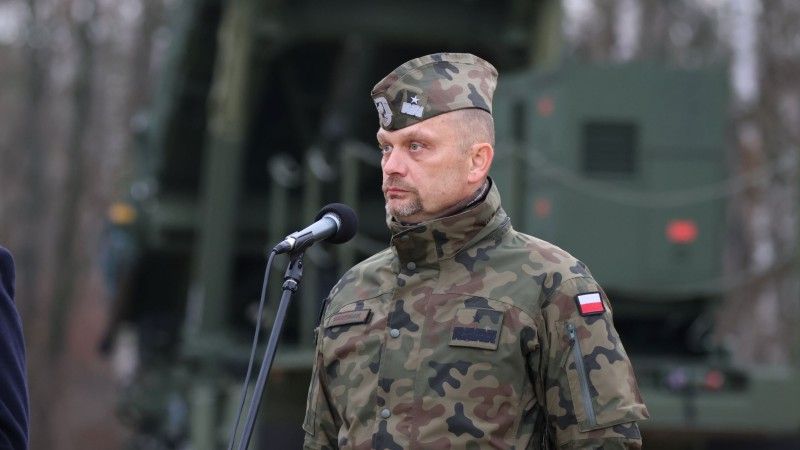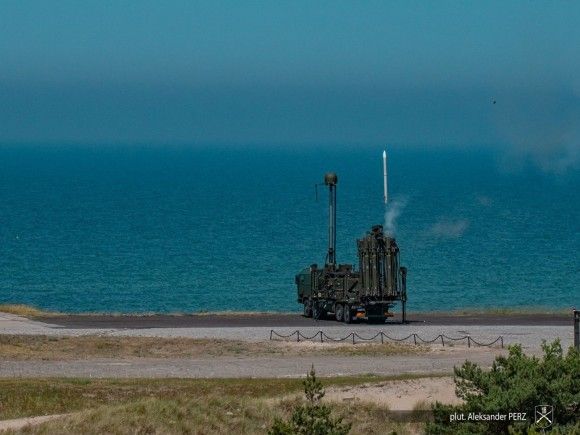Fighting Drones, Air Defence. The Armament Agency Presents Its Plan [INTERVIEW]

Photo. Armament Agency of the Polish MoD
„The plans are ambitious, but also costly,” said Brigadier General Dr. Eng. Michał Marciniak when asked by Defence24 about protecting Poland from drone attacks. We discussed the development of the country’s air defence.
At what stage the modernization programmes regarding the Polish air defences are? What would be the next steps in building the protective umbrella, under the skies of Poland? Will the Polish Pilica+ and Piorun systems face further development? We’ve asked Brig. General Michał Marciniak, Ph.D. Eng., Deputy Head of the Armament Agency, Plenipotentiary at the Polish Ministry of Defence for Building the IAMD System regarding those, and other matters.
Jędrzej Graf, Defence24.pl: General, at the end of last year the Wisła system in its IBCS configuration achieved Initial Operational Capability (IOC). What does this mean and what are the next steps? When will additional elements from the Polish industry – for example, communication nodes and radars – be integrated with the first phase of Wisła?
Brig. General Michał Marciniak, Ph.D. Eng.: Achieving IOC with the Wisła system was linked to the completion of the phase focused on training the individual skills of our personnel. In our ‘jigsaw puzzle,’ it was one of the most important milestones. Currently, we are in the phase of integrating at the battalion level and conducting combat training. Once that phase is completed, the system will reach Full Operational Capability (FOC). It is worth mentioning that before FOC is officially announced, there will be a live-fire missile exercise at the range in Ustka, which will confirm the proper functioning of the entire system and its associated procedures.

Photo. Platoon Leader Aleksander Perz / 18th Mechanized Division/Facebook
In parallel, work is underway to supply Polish components for the Wisła system, such as command cabins (EOC, Engagement Operation Centers - eds.) and mobile communication nodes. The delivery of these elements and their integration with components produced in the USA should be completed by 2027.
I would like to take this opportunity to thank everyone who has been and remains involved in this process, from my team at the Integrated Air Defence Headquarters within the Armament Agency, through the anti-air personnel of the General Command of the Armed Forces and the General Staff of the Polish Army, to all those supportive of our cause in various institutions of the Ministry of National Defence, and finally to the soldiers of the 3rd Warsaw Air Defence Brigade and the 37th Air Defence Missile Battalion.
How Is the Second Phase of the Medium-Range Air Defense Program Being Implemented? In light of the current situation, should we expect changes in the system’s configuration, such as unplanned missile purchases?
The second phase of the program is proceeding according to plan. Most of the purchase agreements under the Foreign Military Sales program have already been signed – covering LTAMDS radars, M903A2 launchers, the IBCS system, PAC-3 MSE missiles, cryptographic components, and technical support from American government agencies. These contracts are now entering the execution phase. At the final stage, there will also be an agreement covering technical security and training laboratories, as well as contracts for training Wisła system operators.
For 2025, we also plan to sign contracts with the Polish defence industry for domestic components of the system. Based on our experience from the first phase, we will contract for command cabins, mobile communication nodes, special chassis, radars – including the Passive Location System – and the remaining equipment necessary to complete the subsequent batteries of the Wisła system.

Photo. Armament Agency
At present, no changes in the configuration of the Wisła system are planned. However, work is underway on developing the CAMM family missiles and their integration with the IBCS system (as part of the Narew program). It is assumed that, provided the basic requirements for the medium-range system are met, the CAMM missile in its MR version will soon be used as a so-called Low Cost Interceptor within the Wisła system.
We are also considering the possibility of supplementing the system with existing effectors, for example, the PAC-2 GEM-T. Additionally, discussions are underway regarding a joint, international program for developing a future combat element known as FCM (Future Common Missile).
The second phase of Wisła also involves integrating Polish elements – radars and CAMM-ER missiles – from the Narew system. What are the next steps and when can we expect the first integrated Wisła-Narew system?
As part of the Narew program, we are working to integrate with the IBCS system the Bystra, Sajna, P-18PL, and SPL radars (via the SMS system). In addition, the CAMM-ER missile, along with its launcher and iLauncher, is also being integrated with IBCS. According to the adopted schedule, the first tests of the entire system are planned for 2027, with further tests in 2028 (related to live-fire exercises at the WSMR range in the USA). This should lead to the full integration of the Wisła and Narew systems.

Photo. Platoon Leader Aleksander Perz / 18th Mechanized Division/Facebook
The decision to implement the IBCS system into the Wisła-Narew program was made almost a decade ago. How do you assess that decision today, considering the experiences in Ukraine and the evolving threat from Russia?
It is true that the concept of a network-centric command system has been the foundation of the Wisła system from the very beginning. However, the decision to employ IBCS for both Wisła and Narew was made in 2019. In light of recent years and the events beyond Poland’s eastern border, it must be stated that the Polish Armed Forces could not have made a better decision than to build an integrated air and missile defence system based on the IBCS system and elements of the Patriot and Narew systems.
The current tactics of a potential adversary clearly indicate the necessity of deploying a dispersed arrangement of air defense units to ensure survivability and effective engagement with the enemy. The capabilities provided by IBCS ensure that air and missile defense based on this system is – and will remain – effective against both current and future threats.
I would also like to take this opportunity to thank all those who (fortunately, unsuccessfully) pushed for running the Wisła and Narew programs separately with two different command systems. The more they were against it, the greater our team’s motivation.

Photo. Polish General Command of the Armed Forces
How will the Pilica+ system be developed, especially with regard to countering unmanned systems? What resources are planned for this purpose, taking into account Russia’s use of Shahed drones, as well as the potential for further acceleration of production and the technological advancement of UAVs in this class? Is the use of interceptor drones, programmable munitions, or directed energy systems envisaged?
Unmanned systems represent a challenge for the entire Polish Armed Forces. This is the approach we must adopt – including within the Armament Agency – regarding our capability to counter aerial objects of the unmanned variety.
Furthermore, I would like to emphasize that a new branch of the armed forces has effectively been created to address this area.
Moving on to specifics: as part of the Pilica+ program, we plan to expand our capabilities to counter unmanned systems by implementing the Nida program after its preliminary redefinition. Together with the General Staff of the Polish Armed Forces and with the participation of the BSU Inspectorate, we have developed directions for the evolution of anti-drone systems, which are now being implemented. In a few months, the Armament Agency will take the first step by commencing the modernization of the SKYCtrl system, while also accounting for the possibility of spiral development in our counter-UAS capabilities. The plans are ambitious, but also costly. At present, the most important task is to secure an appropriate level of funding for these programmes, and thereby for the General Staff to prioritize the design of anti-drone systems.
The Piorun system was submitted to the EDIRPA program, but without success. Can you confirm that the Polish system ended up on the reserve list? Is domestic financing for developing Piorun to the Piorun NG standard planned, in case the program does not receive a European grant?
Yes, I confirm. According to the decision of the Minister of Defence, the EDIRPA program is being implemented according to the adopted schedule, despite our proposal being placed on the so-called reserve list.

Photo. PGZ
At the same time, I can confirm that within the Arms Agency we have initiated steps to ensure the development of the Piorun missile. We have already held initial discussions with the missile manufacturer during which we discussed the directions for modernizing this effector. I want to assure you that the Piorun MANPADS will remain a MANPADS (Man-Portable Air Defense System).
The offset in the second phase of the Wisła program includes the production of ammunition components for the Homar-A system. At what stage is the Homar-A program? Is an agreement expected to be signed this year for over a hundred launchers? What about the remaining vehicles envisaged by the framework agreement?
The implementation of the Homar-A program assumes the possibility of producing selected components and assembling GMLRS missiles in Polish facilities. We are currently waiting for a written assurance from the American side regarding the scope of the technology transfer, which should enable us to begin negotiations with the system’s manufacturer. Unfortunately, the change in administration across the Atlantic is prolonging this process.
In the Wisła-Narew program we combine American and Polish components, sensors, effectors, and communication elements. Do you see potential to similarly implement other programs in cooperation with the USA, for example by integrating Polish UAVs with Apache helicopters or domestic components in Abrams tanks?
Of course. When we first proposed integrating Polish components with the IBCS system, it was considered too bold a move. As it turned out, setting ambitious goals was the right decision, because today we not only integrate our components with the American system but in several cases we are replacing U.S. components with domestic ones. An example of this is the connectivity of certain IBCS components, which now rely on Polish radio networks.

Photo. Senior Pvt. A. Trypuć / 1st “Mazurska” Artillery Brigade
If anyone comes up with an idea in the area of Apache helicopters or Abrams tanks regarding how, what, and with what to integrate, we are happy to help. I believe that Polish technical ingenuity and the capabilities of our industry and science guarantee our success.
Thank you for this conversation.

WIDEO: Defence24 Days 2025: Premier Defence & Security Conference in CEE